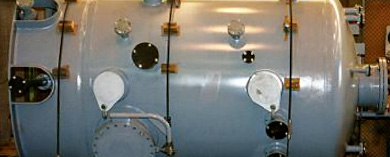
- (03) 5909 8218
- enquiry@fusionweld.com.au
Pressure Vessels: Handling and Maintenance
February 6, 2014

Pressure vessels are containers or storage tanks that have been designed to hold and operate at pressures over 15 pounds per square inch gage. With this kind of pressure, these containers pose a number of safety hazards which means they should be handled with utmost caution and care.
Pressure vessels are used in a wide array of applications in both private homes and heavy industries. Some of the samples of pressure vessels are domestic hot water storage tanks for homes and industrial compressed air receivers for manufacturing plants and other industries. There are also diving cylinders, distillation towers, recompression chambers, autoclaves, pressure reactors, and other like vessels used in oil refineries, mining operations, petrochemical plants, submarine and space ship habitats, nuclear reactor vessels, pneumatic reservoirs, rail vehicle airbrake reservoirs, hydraulic reservoirs under pressure, road vehicle airbrake reservoirs, as well as storage vessels for liquefied gases like chlorine, ammonia, butane, propane, and liquefied petroleum gas.
The pressure variance is hazardous and numerous fatal accidents have happened already. That is the reason why a lot of things that deal with pressure vessel including its design, manufacture, and operation are all evaluated and controlled by authorities supported by legislation. The definition of a pressure vessel is different for every country but they all involve restrictions on temperature and maximum safe operating pressure.
If you are running an industry that uses pressure vessels, your work area has to regularly undergo safety inspections in order to make sure that your containers are free from crack and other damages. The moment pressure vessels develop cracks, they immediately become dangerous. A single crack can lead to leaks and ruptures. Leaks, especially when dealing with pressure vessels with high psig can present major safety concerns. Some of the potential hazardous results of leaking pressure vessels include poisoning, asphyxia, fire, which later on can lead to explosion. Rupture failures caused by leaky pressure vessels may be even more disastrous. They can cause massive amounts of damage to property and life.
To avoid harm and tragedy when using pressure vessels, all necessary precautions ought to be observed. Some of the safeguards that are absolutely necessary when working with pressure vessels include a solid and safe design, proper handling and maintenance, and meticulous installation in line with official codes and standards. These precautions, when followed, are unconditionally essential to protect people’s health and safety.
Because pressure vessels are important tools used in the storage of certain liquids and gasses, it is also important to ensure that they are being operated properly. There is always the danger of injury or even death where high pressure containers are present. For that reason, proper handling and maintenance in both the manufacture and usage of pressure vessels are tremendously important. The right knowledge of local and federal parameters for pressure vessels help in ensuring the safety of everyone involved with them.
Contact Details
Fusion - Weld Engineering Pty Ltd
ABN 98 068 987619
1865 Frankston Flinders Road,
Hastings, VIC 3915
Ph: (03) 5909 8218
Optimized by NetwizardSEO.com.au
Recent Posts
- Scheduling Periodic Laundry Boiler Inspections: Best Practices for Plant Managers
- Glycol Regeneration Units - Manufacturing to Optimise Natural Gas Processing
- Skid Mounted Systems for Oil and Gas Industries: Achieve Mobility and Flexibility
- The Role of Transportable Pressure Vessel Inspections in Ensuring Safety
- Periodic Tank In-Service Inspection: How It Maintains Bulk Storage Tank Integrity
- Static Pressure Vessel Manufacturing: Achieve Maximum Reliability
- Pressure Equipment Management by Fusion-Weld: Key Role in Industrial Safety
- Pressure Piping System Inspection: A Gift of Safety for the Holidays
- Deaerator Inspections by Fusion-Weld Engineering and How They Reduce System Downtime
- Bulk Storage Tank Inspection: Protecting Your Essential Assets
- Pipe Spooling Design and Manufacture: Ensuring Accuracy and Fit
Posts 2023
- Pressure Piping System Inspection: A Gift of Safety for the Holidays
- Deaerator Inspections by Fusion-Weld Engineering and How They Reduce System Downtime
- View all articles…
Posts 2022
- How Fusion Weld Keeps Up With AS-NZS ISO 9001:2008 Standard
- Boiler Equipment Safety Inspection During the Summer Season
- View all articles…
Posts 2021
- Avoid These Factors and Practices that Contribute to Sealing Damage in Pressure Vessels
- Do's And Don'ts Of Industrial Boiler Inspection And Maintenance From Fusion-Weld
- View all articles…
Posts 2020
- What are the Risks and Hazards Involved in Pressure Vessel Equipment?
- How to Know if Your Pressure Equipment Needs Repair or Replacement?
- View all articles…
Posts 2019
- Factors that Contribute to Pressure Vessel Failure
- Pressure Vessel Regulations in Australia: What are the Mandatory Requirements?
- View all articles…
Posts 2018
- Pros and Cons of Spherical vs. Cylindrical Pressure Vessels
- What are the Different Hazard Levels in Pressure Vessels?
- View all articles…
Posts 2017
- Transportable Pressure Vessels: The Importance of Inspection and Safety Checks
- Fracture Mechanics and Stress Analysis of Cracks in Pressure Vessels
- View all articles…
Posts 2016
Posts 2015
- What Are Deaerators & Feedwater Vessels?
- Precautions and Safety for Compressed Air Receiver Vessels
- View all articles…
Posts 2014
- Demonstrating In-process Inspection Procedures
- Static Grounding Practices and Standards
- View all articles…